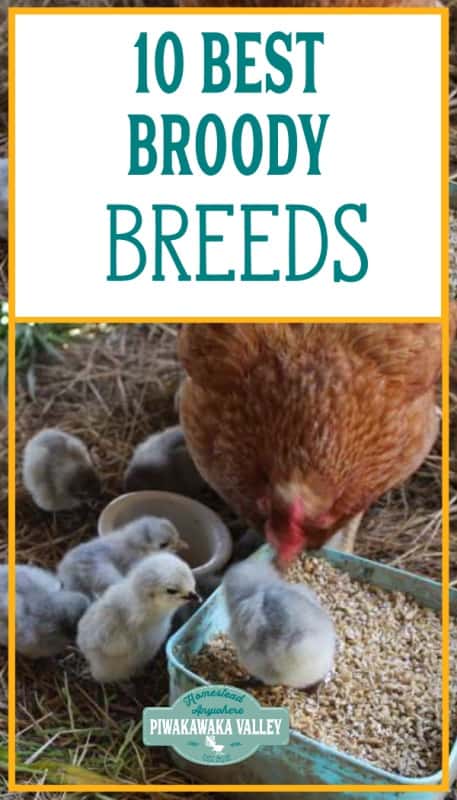10 Best broody chicken breeds
This post was most recently updated on March 10th, 2021
If you are wanting to maintain a self sustainable chicken flock, you will probably be looking for the best broody chicken breeds. Broodiness varies in both breeds and individual birds and will fluctuate over the seasons.
Please read: This information is provided for educational purposes only and is not intended to treat, diagnose or prevent any disease. We encourage you to make your own health care decisions in partnership with a qualified health care professional.
This post contains affiliate links, this means at no extra cost to you, we make a commission from sales. Please read
our Disclosure Statement
What is a broody hen?
A broody hen is one that is wanting to sit on eggs and hatch them out. Hens become broody when they experience hormone changes that make them want to brood (sit on) eggs.
A hen will become broody even if there is no rooster around, and she will sit on her eggs, someone else’s eggs, golf balls or even an empty nest.
Why we want a hen to go broody
A good broody hen will sit diligently on her nest for 3 weeks and hatch out and raise baby chicks. This usually happens in Spring.
She will then raise the chicks until they are independent and then often go on to brood a second time in the Autumn/Fall.
If you have a reliable broody, you can raise and hatch your own chicks without needing to continually buy in new chicks from the farm supply stores.
This is the best way to keep your flock renewing each year, and can give you spare roosters for the pot and spare pullets to sell on. Having a breed of hen that goes broody on your homestead is the most self sufficient way of raising chicks.
If you have your own rooster you can use your own fertile eggs, or you may choose to buy a variety of fertile eggs from someone that sells the breeds that you are interested in raising.
Having a broody hen means that you can avoid the hassle and expense of an incubator and brooder set up.
RELATED: What is best, incubator or hen?
RELATED: Easy expandable brooder
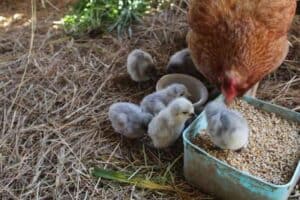

What is the down side to a broody hen
The downside to having a broody hen when you are raising chickens for eggs is that while she is broody and raising chicks she will not be laying eggs for you.
This can take about 3 months all up each time she goes broody, so if she is doing that twice a year, plus off the lay for a molt once a year, you can see it significantly reduces how many eggs she produces.
Because of this, many breeds that are designed for laying eggs have had the broodiness bred out of them. This isn’t to say that they cannot or do not go broody, but that the odd of it happening is MUCH lower.
A broody hen can be aggressive in the nesting boxes to both other hens and humans trying to collect the eggs, and if you don’t want her sitting on eggs she can be a real pest to deal with until her brood breaks.
RELATED: The fastest way to break a broody hen
10 Best broody hen breeds for your backyard flock
Here are the 10 best breeds that I have found to go broody easily and make great mothers.
1. Silkies
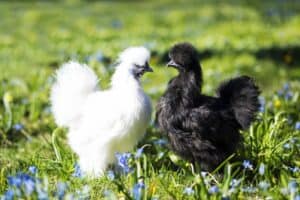

Silkies are a unique breed of bantam that have fluff more than feathers. Known for their pea comb that looks like a brain and a fluffy hair do, silkies have earned the reputation of being the best chickens for going broody easily and making wonderful mothers.
They are small and easy to keep. Silkies are friendly and gentle, and even the roosters make good pets and the hens will readily go broody at least twice a year.
2. Pekin bantams
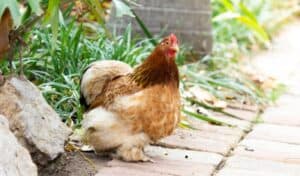

Pekin bantams are cute little floofs that are easy to keep, very sweet and gentle. They aren’t the best layers, and the eggs they do lay are smaller than a standard sized chicken, but what they lack in egg size they make up for in heart.
Pekin bantams make loyal and reliable mothers and most will go broody twice a year.
3. Cochin
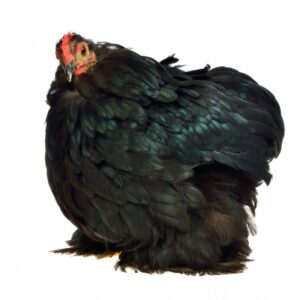

The cochin is a cold hardy breed that comes in a wide range of colours. Known for her rounded feathered tail and mothering instincts, the cochin is a wonderful broody mother hen.
They aren’t known for their laying ability, but this is because your cochin hen is likely to sit on two clutches of eggs a year for you.
They are sweet and friendly and make wonderful pets.
4. Orpingtons
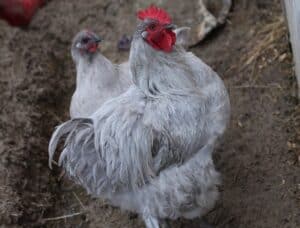

Orpington hens are a great dual purpose bird for the homestead. They are larger in size and the extra young roosters make a good sized meal.
Orpington hens are good layers and the hens will go broody at least once a year in most cases.
Known for their gentle disposition and mothering abilities orpingtons come in a range of colours and are readily available in most places.
5. Brahma
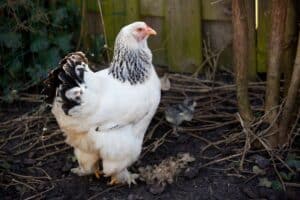

Brahmas are a cold and heat hardy breed known for being good layers. These hens will frequently go broody and make fantastic mothers. Brahmas are gentle giants that do not mind being confined to a smaller yard.
Be aware that their fluffy legs and feet don’t mix well with muddy yards. Brahma are harder to find than orpingtons, but are worth seeking out.
6. Light Sussex
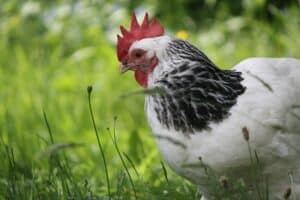

The light sussex is one of my favourite breeds for the homestead. Used in the UK as meat birds, the light sussex grow much faster than most breeds and they grow to a good size.
I have found the roosters to be gentle and the hens are great layers of a large light brown/pinkish egg. The hens make docile but caring mothers.
7. Barnevelda
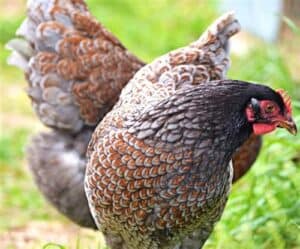

Barnevelda are a medium sized pretty hen. They lay well, a smaller brown egg pretty much every day. Most will go broody at least once a year and they make wonderful mothers.
A placid and friendly breed with lots to offer the backyard breeder.
8. Dorking
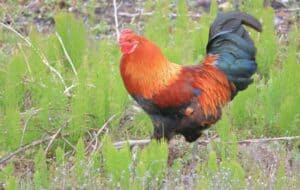

Dorking are an old English breed of chicken. They are short and plump, bred to be dual purpose with an emphasis on breast and leg meat production.
Dorking’s mothering ability improves with age, a hen will lay about 4-5 eggs a week for the first two years then slow down and go broody 1-2 times a year.
9. Icelandic
Icelandic chickens are a super hardy breed of chickens. Originally bred in Iceland, the Icelandic is a landrace breed which means it has been bred for its character rather than its looks.
Icelandic’s come in a wide range of colours, shapes and comb types, but they are all very cold hardy, amazing at foraging for their food, highly alert for predators, light weight and good layers year round. They also will have at least a few that will go broody in each flock each season.
The Icelandic are still hard to find internationally and they cost a lot if you can get them.
10. Plymouth rock
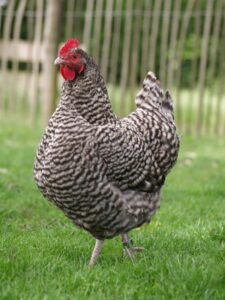

Also known as the Barred rock, the barred Plymouth rock is a large docile dual purpose breed that is commonly kept in farmyards. They are really easy to find, and are popular if you have extras to sell on.
They have been bred for many generations to lay well, grow fast and be excellent mothers.
How many eggs can a broody hen sit on?
The number of eggs a hen can sit on and successfully hatch depends mostly on her size. A bantam hen can be expected to sit on 6-8 of her own smaller eggs or 4-5 larger hen eggs. A medium sized hen can sit on 6 of her own eggs comfortably and a larger hen like a barred rock, light sussex or orpington can usually sit on 6-8 eggs with good hatch rates.
If a hen has to cover too many eggs for her body size the eggs will all take turns at missing out on being kept warm enough and you can lose the whole clutch. Sometimes less is more.
How to care for a broody hen
A broody hen will put her own needs second for the coming months while she broods and raises chicks.
The first thing is to ensure your hen is kept somewhere warm, dark and sheltered. You can remove her from the main flock to reduce the disruption she causes within the flock and to keep her and her egg/chicks safe and undisturbed.
This also ensures that there is plenty of food and water available for when she comes out ready to eat.
If you don’t want your hen broody, it is best to break her brood as quickly as possible.
If she has fertile eggs under her, she will sit for 3 weeks waiting for them to hatch. You can usually hatch ducklings under a chicken as well, but it takes 4 weeks. Luckily hens cannot read a calendar, so she will just keep sitting until they hatch out.
Breeds of Hens least likely to go broody
There are times that you want hens to lay as much as possible and not go broody.
Hens that are bred for laying production are least likely to go broody.
Hybrid chickens that are commercially used to lay eggs are least likely to go broody. In NZ these are Brown shavers and Hyline. In the US they are known as Golden comet, Warren, ISA Brown, Goldline, Gold Star, Lohmann, Gingernut Ranger, and many more.
These are all basically the same chicken bred from leghorn and Rhode island red foundation stock. There are many other hybrids bred for laying also available.
Do you have any of the best broody hen breeds?
If you are trying your hand at self sufficiency, it is a great idea to add at least a few of one of the best broody hen breeds to your flock. Any of them would work, but if you are planning on just adding one with the sole aim of hatching eggs, I would get a silkie or two.


